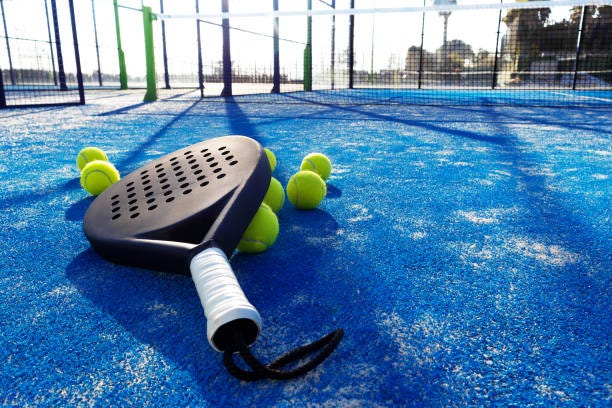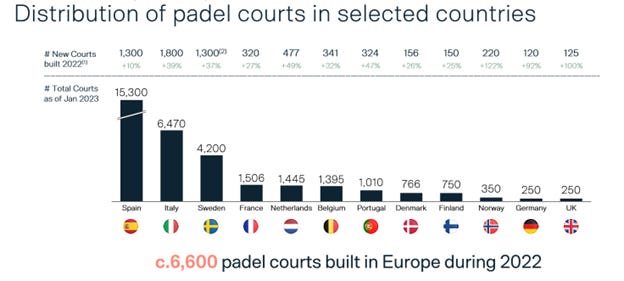The Rise of Padel
The global phenomenon hoping to break into the American Market
Introduction
What’s the fastest growing racket sport in the world whose name starts with the letter “P”? Any guesses? Pickleball? Guess again. It’s actually Padel. Although relatively unknown domestically, growth in Padel has outpaced that of Pickleball outside of the United States over the last decade. Only recently has the sport started to break into the US market, both with professional leagues and recreation-focused facilities.
The big question is whether or not the American sports consumer has the bandwidth to take on another emerging professional racket sport or the interest in adding a new recreational activity to the rotation.
Will the sport grow to the point of challenging Tennis, capturing both fan interest and media dollars? Or will it be relegated to being just another fun activity at big box gyms and country clubs? Numerous investment firms and angel investors are betting on the former. Personally, I’m approaching much more cautiously.
History
Although there are different origin stories, the widely accepted belief is that Padel was created by Enrique Corcuera in 1969 while he was visiting his holiday home in Acapulco, Mexico. Wanting to keep the tennis ball from escaping onto neighbors’ land, Corcuera surrounded his court with walls and fencing. He soon began to create an entirely new sport where one could play the ball off the surrounding walls, and the idea of Padel was born.
A friend visiting Corcuera in 1974 fell in love with the sport and brought it back with him to Spain, where he proceeded to build two dedicated Padel courts. The sport captivated the Spanish population, spread rapidly throughout the country, and began crossing other European borders as well. In 1993, the Sports Council of Spain officially recognized Padel as a sport, standardizing the spelling to "Padel" for pronunciation purposes in Spanish. This official recognition marked a significant milestone in the sport's history, paving the way for its international growth and acceptance.
In 2005, the first professional Padel competition was created, expanding to the first professional league in 2013. The global acceptance has reached a critical point in which it is being considerd for inclusion in future Olympic games.
Whether it’s just been a matter of timing or competition with Pickleball, Padel has yet to become mainstream in the United States. League organizers and industry participants are hoping that will shortly change.
State of the Market
Padel has carved out strongholds in primarily European and Spanish-speaking countries. It makes up for its lack of widespread dispersion with a depth of fanatical support in the countries it has entered. In Spain, for instance, Padel is the second most popular sport behind soccer, with more than 20,000 courts and 6M players. The International Padel Federation projects that more than 25M people play Padel in more than 90 countries worldwide. Chart 1 below comes from industry data research provider Playtomic and shows countries with the strongest Padel following.
Playtomic projects that the total Padel market will surpass 6B Euros by 2026 (2B euros currently), with much of the growth coming from frontier markets, including the UK, Germany, France, the USA, the Middle East, and Asia. Chart 2 shows the projected international adoption of Padel.
The United States is in the very earliest stages of adoption of the sport, with only 300 Padel-specific courts, but that number is expected to double in 2024. Given the rise of Pickeball and the rapid growth of Padel in other countries, industry participants have projected that there will be more than 25k courts and 12M players in the United States by 2030 (compared to ~12k Pickleball courts and ~9M Pickleball players currently).
With potential mass adoption at the recreational and grassroots level and the possibility of a name brand professional league, an entire ecosystem has developed around the sport of Padel, ranging from sports performance tools to clubs to social engagement technology platforms. Below is a non-exhaustive market map of the current Padel ecosystem.
As with many recreational activities, the TAM (total addressable market) expands dramatically with validation at the professional ranks. A few upstart leagues are vying for that standard bearer position.
Professional Leagues
Professional Padel League (PPL)
The PPL was the first professional league to get any traction on US soil when it held its inaugural season in May of 2023. The league was founded by former professional Tennis player Marcos del Pilar and his attorney, Keith Stein.
As standard with most emerging professional sports leagues, the PPL has a suite of notable personalities on its cap table, including musician Daddy Yankee, former part-owner of the Sacramento Kings and Las Vegas Golden Knights Gavin Maloof, and MLS player Sebastian Giovinco. Additionally, the PPL received investment from the Padel-specific venture fund EEP Ventures, formed by a consortium of Swedish professional NHL players, including Filip Forsberg, Jacob Markstrom, Mattias Ekholm, and Andres Nilsson.
For the inaugural season, the PPL partnered with 40 local networks to broadcast games, including BeIN Sports, AT&T Sportsnet, MAN, SWXS Sports, and Spectrum.
For their second season in 2024, 10 franchises will compete in tournaments in Miami, Los Angeles, and New York. The 10 teams for this season are the Toronto Polar Bears, San Diego Sting Rays, Miami Padel Club, Cancun Waves, Los Angeles Beat, Arkansas Matrix, Las Vegas Smash, New York Atlantics, Houston Volts, and the Flowrida GOATSs (no, that’s not a typo).
A1 Padel was founded in 2020 by Monte Carlo businessman Fabrice Pastor as a European Padel circuit. In March of 2023, they announced a strategic partnership and minority investment from Yankee Global Enterprises, the family office of George Steinbrenner, and the ownership entity of the New York Yankees. With the partnership, A1 brought its first American tournament to New York in late 2023 and has discussed plans for Miami and Las Vegas-based events in the future.
Premier Padel is the professional league backed by Qatar Sports Investments. In August 2023, they acquired competitor World Padel Tour, the first professional Padel circuit established in 2013.
In the inaugural season in 2022, the league had over 500 players participate across 8 cities. They landed regional broadcast agreements with over 180 countries and had 22.7M YouTube views. It is truly a global league, with 2024 tournaments being played in Saudi Arabia, Qatar, Spain, Chile, Sweden, Venezuela, Belgium, and Mexico, among a myriad of other countries.
My Outlook
I generally like to take an optimistic viewpoint in this blog but I’d be lying if I didn’t say I have my doubts about the growth potential of Padel, particularly in the United States, at both the professional and recreational levels.
Regarding developing an economically viable professional league, I believe professional Pickleball's growth and subsequent stall should provide a cautionary tale to those building professional Padel leagues. Sportico released an article at the end of 2023 in which they discussed some of the obstacles facing professional Pickleball. The two predominant organizations, Major League Pickleball and Pickleball Professional Association, just finalized a merger agreement more than 10 months after announcing a deal. Financial pressures have forced leagues to cut player pay by over 40%. This is partly due to waning media interest aside from some one-off celebrity matches. Although still a nascent league, I think the struggles faced by professional Pickleball reflect a reality that the growth in participatory interest in a sport does not always mean there is demand for a professional product. Racketball has been around for 50+ years and Squash for 100+ years. Both sports have an avid fan base and are mainstays in rec centers nationwide, yet there still isn’t a notable professional product. Even if Padel continues to grow at a recreational level, this doesn’t prove demand for a professional league.
Not to double down on my negativity, but I’m not confident recreational Padel in the United States is a guaranteed success either. After explosive growth in some countries, partly fueled by pandemic era lockdowns, many countries have found themselves in a situation where supply has outpaced demand. Padel-obsessed Sweden presents an interesting case study. 90 Padel court operators closed their doors and filed for bankruptcy in 2023.
Outside of dedicated Padel clubs, municipalities and fitness facilities will be reluctant to remodel courts once again to incorporate a new offering. Many have just converted Tennis courts to Pickleball courts and/or built dedicated Pickleball courts and invested significant capital in the process. Although similar in appearance, Pickleball and Padel courts have unique characteristics that would prevent multi-use facilities. Padel courts are enclosed in a walled or glass casing, have different dimensions (20M X 10M for Padel and 13.4M x 6.09M for Pickleball), and have a slightly different layout. It was fairly easy to draw down chalk lines and change the net height to convert a Tennis court to a Pickleball court, but it will not be as easy of a transition from Pickle to Padel.
Lastly, and admittedly a bit farfetched, I believe there are cultural barriers that will stand in the way of Padel adoption in the United States. We’re a defiant country by nature and oftentimes embrace what’s ours while rejecting what’s commonplace outside our borders. Our Football vs. your Futbol. Our NASCAR vs. your Formula One (although that’s changing), our Baseball vs. your Crickett. Pickleball was created in the United States and has remained a predominantly American sport. Padel and Pickleball are similar enough that I could see them both growing concurrently but isolated in their respective geographies.
Padel will continue to thrive internationally at the grassroots and professional level, but I anticipate it will struggle to gain traction in the US. It will not be uncommon to come across a private Padel club or see a Padel court at your local rec center, but I do think the American sports consumer has limited bandwidth on the amount of emerging sports properties that he/she can follow and play, and this will prevent Padel from being a true blockbuster success.






